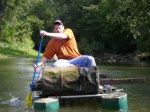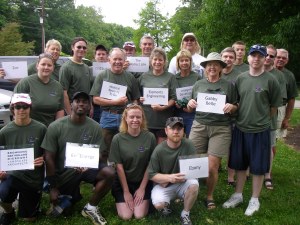What was true in 1970 when Pogo first uttered his immortal words is truer still today. At the time of this writing, my city, Indianapolis (ok, yes I live in Carmel, but much to the chagrin of many Carmelites, Indianapolis STILL is the major metropolitan city in this area), is in the midst of a 17 year project to mitigate it’s sewer overflow problem. Indy, like several hundred other cities, utilizes a Combined Sewer Overflow system. Basically, what that means is wastewater from homes and businesses (uh, sewage!) and rainwater from streets and parking lots utilize the same pipes to transport the water (and the, uh, sewage) to the treatment plants. Sounds logical, right? You only have to lay one set of pipes, excellent! Except…when it rains. That’s where the overflow part of the Combined Sewer Overflow system comes in. When the amount of “water” to be processed exceeds the capacity of the system, it is allowed to flow freely (“floatables” and all) into local rivers and streams. In Indianapolis, the amount of rain required to cause the overflow is ¼”! One quarter of one inch! In 2008, Indianapolis received a rainfall of over ¼” SIXTY times…about 6 or 7 BILLION gallons of sewage a year! Anyone want to go for a swim? How about a nice drink? Or, fish fillet? Want to be grossed out? Check out WTHR’s Bob Segall’s article at http://www.wthr.com/Global/story.asp?S=9260797.
The good news is we are fixing the problem, to the tune of several BILLION dollars, but we are fixing it. The bad news is…we haven’t really learned anything in a hundred years. A recent article in the Indianapolis Business Journal featured the “dewatering system” of the new 1,000 room Marriott hotel in downtown Indianapolis. This $425 million project is part of our city’s plans for hosting the Super Bowl in 2012. “Dewatering System” sounds so innocuous doesn’t it? Sounds almost like a dehumidifier or something, right? So, what exactly is a “dewatering system”? Many of you have homes with basements; undoubtedly you have a sump pump. These systems are designed to funnel water to the pump where it can be moved away from the foundation of the house. They help to prevent water from leaking through the foundation of the house into your basement. On a much bigger scale, that is the type of system engineered at the Marriot. Still sounds pretty harmless, right?
The system at the Marriot has a series of almost 5,000 feet of PVC pipe, funneling water to sump wells that are four feet wide and nine feet deep. There are four pumps that run every minute of every day pumping 1,200 gallons of water a minute. That’s 1,728,000 gallons a DAY, or 630,720,000 gallons a YEAR! That is enough water to supply 10,000 households for an entire year! And, what are they doing with all that water? According to the senior project manager they are sending it “right to the [White] river”. Hmmm, so they ran a pipe west from those pumps over a ¼ mile UNDER White River State Park to the river, or was it south almost half a mile under Victory Field, or north under the Eiteljorg and the Indiana State Museum. Uh, I don’t think so Tim. If I were a bettin’ man, I’d bet they will pump 630,720,000 gallons of water each year into the Indianapolis Combined Sewer System, where it not only adds to the amount of waste water that has to be handled by the system, it also has to go through the waste water treatment facility and be processed before it goes “right to the river”.
What design issue led to the decision to pump over a ½ a BILLION gallons of water into the Combined Sewer System? The three story BELOW ground parking garage is five feet deeper than the level of the water table on the site….five feet. So, think about this…how many buildings in downtown Indy have three floors of parking, or other space below ground and are pumping just as much, if not more water into the Combined Sewer? Dozens? Hundreds? In some states, it is a criminal offense to capture the rain water that falls on your property, yet we are literally flushing billions of gallons of water each year down the drain…AND we are all paying for it. Not only are we paying for the project to overhaul the sewer system and the capacity to handle water that was not entering the sewers to begin with, but we are paying for the waste water treatment facilities and operations, and we pay for it in the damage all this water has on the river itself. One day, in the not so distant future, we are going to be desperate for water to drink. Think of the cost that will entail!
Surely in this day of Low Impact Development and Sustainable Design we can come up with better solutions than just dumping the water down the drain. How about a two story parking garage, instead of three, how about building above ground instead of below, how about using that water to flush the 1000 or so toilets in the new hotel and for other non-drinking uses, how about filtering it and using it in the hotel pool? How about building codes that require developers to USE the water on their site rather than just pumping it into the water system?
The impacts of design decisions like this one go far beyond the strain it places on our sewer infrastructure. The great environmentalist John Muir once wrote, “When one tugs at a single thing in nature, he finds it attached to the rest of the world.” In my next post, we will examine some of the other impacts of the “dewatering system” on, not only water, but energy, carbon, and human health.

 I could go on and on…but what I really wanted to do was to thank the 14 people that gave up 5 or 6 hours of a gorgeous September Saturday morning to provide the muscle needed to accomplish this daunting task! Our 11 canoeists were ably supported by a land crew of three that helped shuttle us along the route and made sure lunch was ready when we were finished. The 11 members of the water crew weere in six canoes (thanks Alan for volunteering to go solo!) and had a fantastic barge provided by the City of Noblesville. Within the first quarter mile we had amassed so much stuff, we had to offload the barge and a couple of canoes at the 206th bridge, where a group of boy scouts helped to move it to the dumpsters.
I could go on and on…but what I really wanted to do was to thank the 14 people that gave up 5 or 6 hours of a gorgeous September Saturday morning to provide the muscle needed to accomplish this daunting task! Our 11 canoeists were ably supported by a land crew of three that helped shuttle us along the route and made sure lunch was ready when we were finished. The 11 members of the water crew weere in six canoes (thanks Alan for volunteering to go solo!) and had a fantastic barge provided by the City of Noblesville. Within the first quarter mile we had amassed so much stuff, we had to offload the barge and a couple of canoes at the 206th bridge, where a group of boy scouts helped to move it to the dumpsters.




